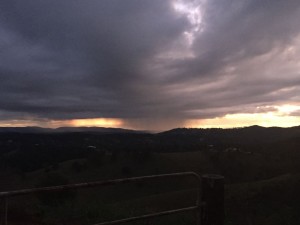Brief update from my previous post: I FOUND BLACK BEANS. I heard rumors that black beans occasionally grace the shelves of the nicer grocery stores, and we finally had a chance to go this week. They were expensive, so I was only allowed to buy one can using our grant money, but I take what I can get.
Anyway, on to the next topic.
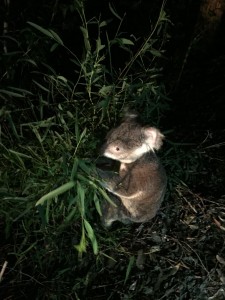
Since my position as a field technician this summer entails spending all of my time in the outdoors observing how wildlife and the habitats they live in influence each other, it’s hard not to notice the impact we as humans have on the environment. Usually “impact we have the environment” calls to mind the obvious negative havoc that humanity has wreaked on the planet—oil spills, habitat destruction, pollution of various kinds, endangering of species, etc. Most of the impact I have observed is often indeed detrimental, although not always so obvious and sometimes unintentional. One of the most noticeable human impacts is the presence of invasive species in the area. So many plants and animals are introduced, sometimes by accident, sometimes deliberately, and many of them have really taken over.
The cottage my coworkers and I are staying in is on a mountain ridge, forested by rainforest species that the landlord is planting in an effort to restore the natural habitat. There is a track around the property we’ve walked around in search of koalas and echidnas, and we noticed that, despite his attempts to vigorously remove invasive species and replant natives, a number of weedy nonnative plants we see at our field site are growing along the trail at the cottage.
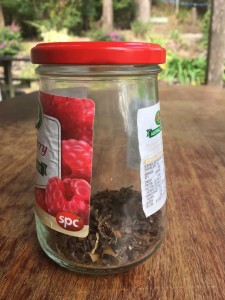
The landlord said that he never had some of these plants before field crews started staying at his cottage; apparently seeds stuck to our clothes and planted themselves at the cottage when we return from the field. Knowing this, we’ve started collecting all of these “hitchhikers” into a “Jar of Sadness,” and the size of the pile is quite impressive. It shows us all of the invasive weeds we would have otherwise been spreading.
However, introduced species do not always have negative impacts, and not all invasive species are introduced. We heard about a bird, the bell miner, whose range has recently been spreading and who is aggressively taking up resources and habitat from a lot of native species. The catch—the bell miner is also a native species. So, why this new range expansion? Why is it causing so many problems when it theoretically “belongs” in Australia? It turns out that bell miners thrive on the edges of forests and in degraded habitat, so as people destroy habitat, the bell miners are able to take over and push out species who would otherwise be trying to live there.
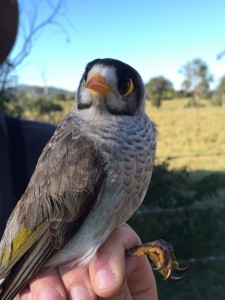
As I’ve said, it seems that invasive species takeover is incredibly widespread here in Australia. While that kind of situation usually comes with sad stories of loss of diversity and habitat, I’ve been impressed with the adaptability of some of the species here. Lantana, a bush that is native to tropical Americas (I recognize it from Miami, where I grew up), has completely taken over most of the habitats I’ve encountered in Queensland. It occurs throughout the field site and is one of the primary species our landlord is battling on his property. When I first looked through bird identification guides at habitat descriptions for some of the birds, I was amazed to see that lantana was significant enough to merit mention in many of the descriptions (e.g., open meadows, farmland, lantana). While removing an invasive species could allow native plants to regain their footing, however, the lantana also provides habitat for a number of birds, and removing it would impact bird species diversity since it is now so established that so many species have adapted to it. Similarly, according to the Queensland Museum, rabbits and hares compose over 70.5% of the diet of wedge-tailed eagle, an Australian native, even though rabbits and hares are nonnatives and the eagle must have been eating something else prior to their arrival. These stories make me ask so many questions about the ethics of removing invasive species, conservation of natives, and the resilience and adaptability of the living systems in our environment.
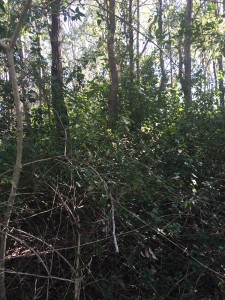
As humans, we have other kinds of impacts, too, which are sometimes necessary in the long run. For example, we must catch the birds we are studying in order to put color bands on them so we can observe them later and identify individuals. To do this, we locate a flock, set up mist nets that the birds have trouble seeing, and herd the birds into the nets. To study something, there is inevitably impact—the birds become more wary of us after we have caught and released them, and the net lanes (areas of trampled grass from where the nets were set up) remain some time after we have left. These impacts are minuscule, but are impacts nonetheless. Our landlord recently built a new track on his property, which involved bulldozing trees and packing down the earth. In the process, a number of plants were destroyed, and there certainly was insect and fauna loss, such as giant worms who live in the leaf layer. It was sad to walk on the path after having just walked through the unplowed forest the day before, but this track will allow him to access other parts of his property and more easily remove invasive lantana and guava and maintain the native plantings in the future. It’s an uncomfortable-but-for-the-greater-good kind of feeling. But having a feeling like that, I think, is a good thing—not being totally satisfied with accepting that the impacts we have are necessary and unavoidable can give us incentive to find new, less impactful methods in the future.
